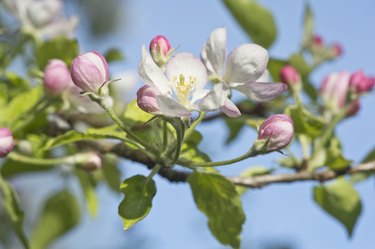
Do flowers turn into fruit? Yes, many flowers on your garden plants, trees and shrubs will develop into fruits. In some cases, this means that not only can you enjoy the beautiful blooms your plants have to offer, but you also have a food source and get to enjoy the tasty fruits later in the season. Not all fruits are edible though, but they still serve an important purpose for the plant.
Types of Flowers
Video of the Day
Flowers are the reproductive parts of plants and there are several different types of flowers. Many plants have perfect flowers. This means that each flower has both male and female reproductive parts. For example, trees in the Prunus genus have perfect flowers. This includes sweet cherries (Prunus avium, USDA zone 3-8) and peaches (Prunus persica, USDA zone 5-9).
Video of the Day
Some flowers are imperfect, meaning that flowers either have all male or all female reproductive parts. Some plants, such as summer and winter squash (Cucurbita pepo and Cucurbita maxima) and walnut trees (Juglans regia, USDA zones 3-7), have imperfect flowers with both male and female flowers growing on the same plant. These plants, as well as plants with perfect flowers, are considered monoecious.
Other plants may be dioecious, producing only male or only female flowers. If you grow these types of plants, make sure you plant both male and female plants to ensure the female flowers are pollinated and can produce fruit. Some examples include persimmon trees (Diospyros kaki, USDA zones 7-10) and kiwifruit vines (Actinidia chinensis var. deliciosa, USDA zones 7-9).
Flowers Fertilization Requirements
Do fruits come from flowers? They do develop from both perfect flowers and imperfect female flowers. Imperfect male flowers do not turn into fruits, but they play a critical role in fruit development. Before fruits develop, the female flower must be fertilized with pollen from the male parts of the flower. Some flowers are self-fertile and can pollinate themselves without any outside help.
However, other flowers, such as those on apple trees (Malus domestica, USDA zones 4-9) may need to be cross-pollinated with pollen from other plants. One of the most common ways this occurs is by pollinators such as bees. The pollinators are attracted to the flower and feed on the nectar. When they do this, they collect pollen which can then pollinate other flowers that the bees visit.
Some flowers benefit from both types of fertilization. An example is the strawberry plant (Fragaria spp., USDA zone 5-8).
Flowers Turn Into Fruit
Once the flower is fertilized, it can develop into a fruit. What part of the flower becomes fruit? The ovary of the flower is the part that will eventually become the fruit. The ovary is quite visible on some flowers, such as squash flowers. At the base of a female squash flower, you will see a larger stem that looks like a miniature squash.
Some plants, like strawberries, are a bit different. Each strawberry is actually made of many fruits, each of which is a fertilized ovule or achene. If you find a strawberry that seems undeveloped on one side, this is likely because the flower wasn't fully fertilized and the unfertilized ovules didn't develop.
Types of Fruits
When you think about plants with fruits and flowers, you likely think about sweet edible fruits, like apples, peaches and strawberries. However, there are other types of fruits, or matured ovaries. This means that many vegetables, including squash, are actually the fruits of the plant.
Some other types of fruits include pods, which are common in members of the legume family such as peas (Pisum sativum) and peanuts (Arachis hypogaea) and samara, or winged fruits, such as those produced by maple trees (Acer spp., USDA zones 4-8).
The purpose of fruits is to spread seeds so that the trees can reproduce. Some fruits and seeds fall to the ground while others may blow away in the wind or in water. Fruits and seeds may also be dispersed by birds and animals that consider them a food source.